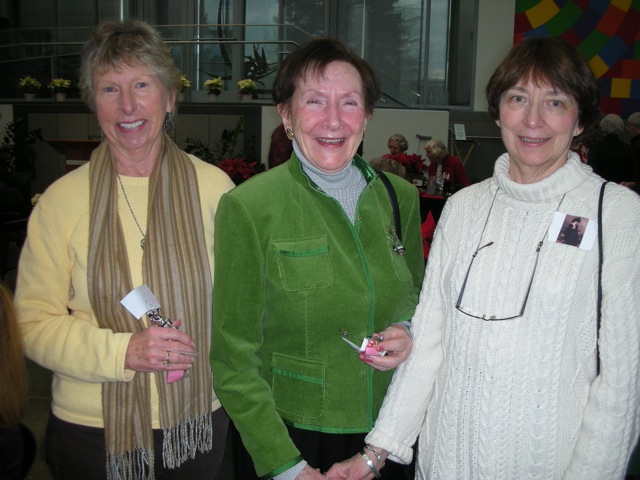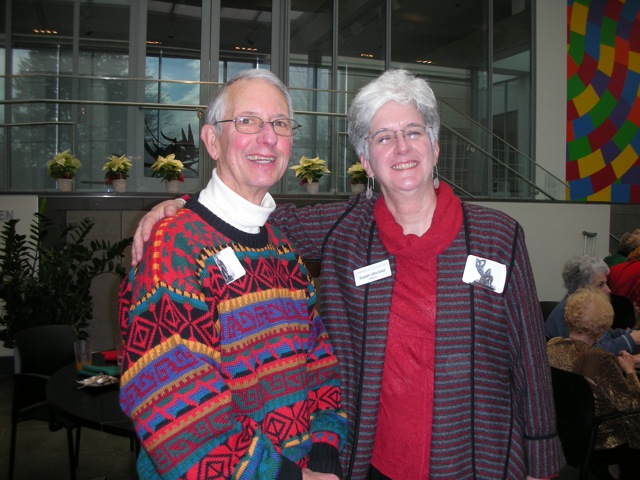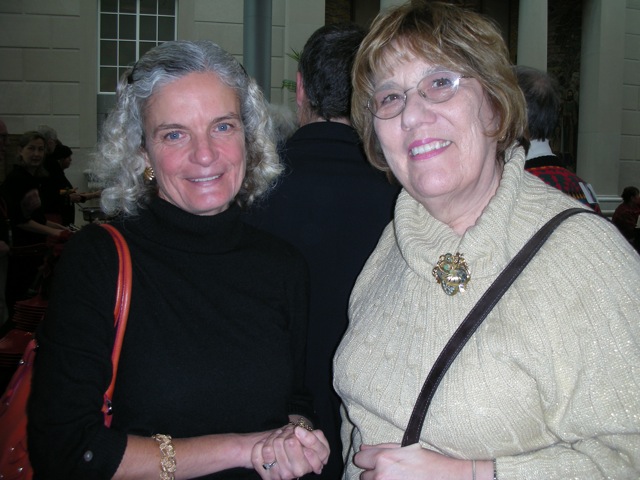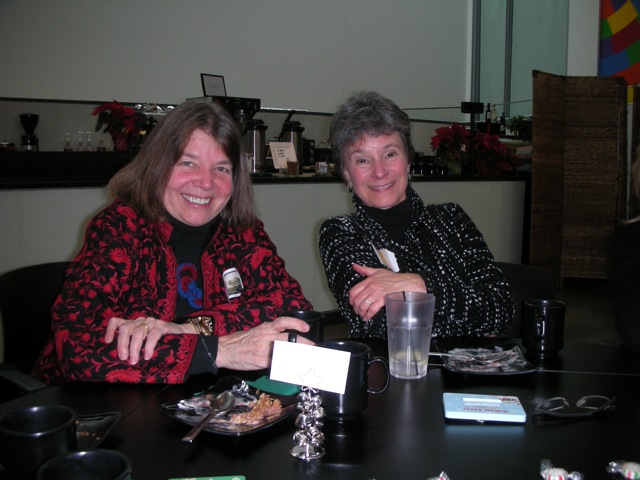Executive Committee
Officers
Executive Chair:
Carol Tingleff
Executive Vice Chair: Thelma Raine
Treasurer:
Peggy Rogers
Secretary:
Yvonne Dunham
Committee Chairs
Guild Meetings & Programs: Peg Case
Guild Membership:
Barbara Shepler
Guild Communications: Jackie Parsons
Museum Docents:
Carolyn Hollman
Zimmerman House Docents: Dennie Dyer
Special Projects:
Pam Parrot
|
The Currier Guild in Action eNewsletter Staff
Editor: Jackie Parsons
Production Assistance:
Neva Cole,
Flo Fitzgerald,
Michelle Pennington
| |
|
|
The Annual Business Meeting & Luncheon for the
Currier Guild of Volunteers
will be held onTuesday, May 18, 2010at theManchester Country Club
Invitations
will be sent in April. Conversation, Registration, Coffee - 9:45 am
Meeting begins promptly at 10:15 am
Cash Bar
Speaker: Robert Larsen, watercolor artist
Topic: "Masterworks: Making Watercolor Behave"
|
Stay Warm: View the World from the Currier's Windows
Arriving at the Currier one recent cold Saturday, I found the parking lot completely occupied. Even without the draw of a special exhibition, visitors found the warmth of the museum an inviting way to spend some precious weekend hours. Did they gravitate toward Tarbell's Summer Breeze or Mercie Cutting Flowers in an attempt to forget the winter chill? Perhaps Sharon's Sleigh Ride Party or Mount Monadnock in Winter were appealing views -- as if looking out a window at a familiar New Hampshire scene but from comfortable surroundings.
Just as we have artwork depicting widely varying views, we have volunteers doing a wide variety of jobs for the Currier. Some have the opportunity to interact with other volunteers and others find the role they have chosen is more of a task for an individual. This makes it difficult for them to express their views and offer their suggestions.
We are considering instituting periodic meetings for volunteers, especially those who are not involved in the docent programs. Perhaps we could schedule them to coincide with our staff talks. If you are interested, I would like to hear from you.
Thank you,
Carol Tingleff, Executive Committee Chair
ctingleff@msn.com
603.673.5319
|
Total 2009 Volunteer Hours: 11,713
Congratulations and thank you to all 109 volunteers who donated 11,713 hours to the museum in 2009! This represents an average of over 100 hours per person.
Here is a breakdown:
- 52% of volunteer hours were counted in the shop, special projects, visitor services, and trainings
- 48% of volunteer hours were contributed in tours
- 69 volunteers served more than 50 hours
- 30 volunteers served more than 100 hours
- 12 volunteers served more than 200 hours
- 3 volunteers served more than 300 hours, and
- 2 volunteers served more than 400 hours! Amazing!
Barbara B. Shepler, Membership Chair
barbara.shepler@yahoo.com
|
Museum Ambassadors Participate in Hospitality Training
As we welcome in the New Year, we also welcome our new core of Museum Ambassadors. During the last two months of 2009, we held a number of training sessions in preparation for this program. Two were internal training/orientation sessions within the museum. This allowed us to review all areas of operations and reorient ourselves with the overall way-finding within our newly-designed building. Next we held a "Hospitality Training" session hosted by Judi Window from the Granite State Ambassadors. This training gave us an overview of what our city of Manchester -- and beyond -- has to offer to our visitors. Through this we received a number of great resources to use as reference and as "take-aways," such as highway maps, regional guidebooks, and travelers handbooks. We had a great turnout for all sessions, which left the group feeling prepared and enthusiastic.
We've posted a sign-up calendar in the guild room for the ambassadors with shifts suggested at 45-minute intervals. With graphic designer Neva Cole's assistance with design, we've created our new Museum Ambassador Buttons to better identify the ambassadors so visitors are more open to engaging with us.
Although we're experiencing a relatively slower period in terms of visitation, there is a current need for museum ambassadors on Saturday mornings.
We look forward to a more vibrant launch of the program with the start of our upcoming exhibition, From Homer to Hopper: American Watercolor Masterworks from the Currier Museum of Art, which opens to the public on March 6.
Barbara Case, Manager of Visitor & Membership Services
bcase@currier.org |
Volunteers Assist Staff with Projects
Special Projects involves well-defined, short-term projects that are requested by Currier staff members. Recently, Michelle Pennington, associate educator, asked for a volunteer to compile a list of organizations and others most likely to be interested in the upcoming watercolor exhibition to better target the market. A volunteer offered to help with this task which was completed in February. Other recent projects included entering data and interacting with visitors in the museum to fill out questionnaires regarding their experience at the Currier.
It is important for the list of available volunteers to be current. I will be sending out an email to our list of names to ask if you want to remain on the list for this year or if you want your name removed. If you are on the list and find you are no longer available for Special Projects, please let me know. If you would like to be added to the list, please contact me.
Pam Parrot, Special Projects Chair
pamparrot@comcast.net
603.580.2188 |
Museum Docents Share Best Practices
During January and February, public tours of the permanent collection, tours for school groups, and tours with a special focus kept everyone busy even though the special exhibition galleries were closed for floor sanding.
The docents met every week both in small groups (to exchange information) and in larger groups (to view and discuss films related to artists represented in the collection). The small group exchanges, called "Sharing Best Practices in the Galleries," are an innovation of Jane Seney, educator for tour and docent programs, and they proved to be extremely informative and lively.
In March, Currier Director Susan Strickler will provide docents with a special walk-through of the watercolors exhibition. Judith Walsh will present an ARTalk on watercolor techniques and materials. Docent presentations on focus tours, "Learning from Each Other," will continue through March and April.
The docent steering committee met on February 23 after docent training. The purpose of this committee is to act as a liaison between the museum docents and the staff of the Currier. The committee represents the docents and is a vehicle for them to bring forward any ideas, concerns, and suggestions they may have.
This year's committee members are Jane Bentas, Carolyn Hollman, Pat Howard, Nancy Johnson, Ann Richardson, and Carol Tingleff. Jane Seney chairs the committee. The committee urges docents to contact any member or Jane with items they would like discussed. There will be a general session later in the spring where everyone can discuss issues together in a larger forum.
As most know, in January artist Jon Brooks suffered an electrical fire that destroyed his studio in New Boston, including his works in progress and his specialized tools. Many of us have visited the Brooks' house and studio and feel particularly saddened by these events. For further information about the fire and about ways to help the Brooks with a donation, click here.
On a brighter note . . . while we look forward to the coming months, the photos from the December Holiday Party remind us of some of the many collegial and happy times we have shared. Enjoy!
Carolyn Hollman, Museum Docent Chair
chollman@aol.com
|
|
Photo Gallery: Docent Holiday Party

Ann Richardson, Thelma Raine, and Nancy Stewart. Photo by Carolyn Hollman  Ted Parrot and Susan Strickler. Photo by Carolyn Hollman  Liz Richter and Nancy Johnson. Photo by Carolyn Hollman.  Judy Ransmeirer and Roberta Lavey. Photo by Carolyn Hollman |
Words Matter
As I give and take tours I am often confused by terms used to describe work being done on historic structures. In an attempt to learn about these activities, I found the following definitions:
Preservation: The act or process of applying measures necessary to sustain the existing form, integrity, and materials of an historic property. Work generally focuses on the ongoing maintenance and repair of historic materials and features rather than extensive replacement and new construction.
Rehabilitation: The act or process of making possible a compatible use through repair, alterations, and additions while preserving those portions or features which convey the historical, cultural, or architectural values of an historic property.
Restoration: The act or process of accurately depicting the form, features, and character of a property as it appeared at a particular period of time by removing features from other periods in its history and reconstructing missing features that existed during the period to which the building is being restored.
Reconstruction: The act or process of depicting by means of new construction the form, features, and detailing of a non-surviving site, landscape, building, structure, or object for the purpose of replicating its appearance at a specific period of time and in its historic location.
Think you have it? Test your skills:
At the Zimmerman House, to which category do the following activities belong?
- Recent work on the mailbox
- Installation of the combination dishwasher and sink
- Removal of the TV
- Tile Roof Installation
- Work done on the banquette cushions
- Installation of the new temperature control
(For answers, scroll to end of enewsletter.)
Dennie Dyer, Zimmerman House Docent Chair
dennie.dyer@comcast.net |
The Convergence of Art and Art History
One of the goals of the Currier's new Strategic Plan - supporting work that has been ongoing for a number of years - is to tie the Art Center, and the art studio experience, more closely to the museum. In turn, an increasing focus at the museum is on how things are made. The interpretation for the current watercolor exhibition is a good example: the audio tour (the Currier's long-awaited first!) features both Currier Director and Exhibition Curator Susan Strickler and Art Center Director Bruce McColl, a practicing artist, exploring watercolor as a medium.
Using an exhibition based on a single media as an opportunity to discuss creative process is one part of a larger institutional effort to link art-making with art history. For centuries, artists have been inspired by the work of other artists and the students of the Art Center have a unique opportunity not enjoyed in any other art school in New Hampshire: to be inspired by and learn from the museum collections. On the other hand, with the proximity of the Art Center and its working artists, the interpretive experience of visitors can be greatly enriched by a better understanding of how art is made.
To further this conversation, we have invited watercolor painter Robert Larsen to be the speaker at the Guild of Volunteers Annual Meeting, May 18, to talk about how he is inspired by the exhibition From Homer to Hopper. We hope this is the beginning of a conversation that enriches both artists and appreciators of art.
Susan Leidy,
Deputy Director and Staff Advisor to the Guild |
Do You Know the Currier Library Hours?
Tuesday: 8 am to 4 pm
Wednesday: 8 am to 4 pm
Thursday: 10:30 am to 4 pm
Contact Alison Dickey for library access: adickey@currier.org
|
Answers to WORDS MATTER:
- Recent work on the mailbox: Preservation
- Installation of the combination dishwasher and sink: Restoration
- Removal of the TV: Restoration
- Tile Roof Installation: Reconstruction
- Work done on the banquette cushions: Preservation
- Installation of the new temperature control: Preservation
| |
|
|
|
|
|